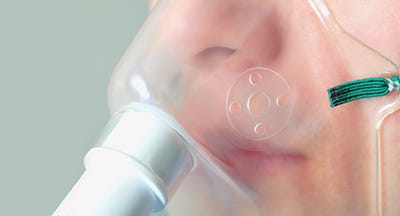The air we breathe is 21% oxygen and normally sufficient for healthy humans. However, the onset of chronic or acute lung diseases can reduce the body's ability to absorb oxygen and therefore supplementary oxygen must be provided. This oxygen must be prescribed by a doctor and can benefit patients who suffer a range of respiratory-related illnesses and diseases by improving their overall mood, energy levels, and health outcomes.

What is Oxygen Therapy?
Oxygen therapy is a treatment that gives the user extra oxygen to improve their physical and mental health. This can be required when a person is affected by certain diseases or conditions which prevent the body absorbing enough oxygen from the air. The oxygen is administered using a metal cylinder and flows through a tube straight to the lungs. There are several administration methods depending on the patient, all of which allow the user to breathe up to three times as much oxygen as they normally would. This process is designed to increase energy levels and general activity while contributing to better overall health.
How Does it Work?
The first step is for a doctor to decide whether a patient will benefit from oxygen therapy. Often this involves a test that measures how much oxygen is present in the blood. Certain acute, chronic diseases (such as pneumonia) can have an adverse impact on the transfer of oxygen from the alveoli into the blood. Once it is established that a patient will benefit from the treatment, oxygen can be administered via a nasal cannula, face mask or through the windpipe. The tubing itself will connect to an oxygen machine, or tank, both of which provide the patient medical grade oxygen. Oxygen therapy can be done in a clinical setting such as a hospital or in other circumstances it can be administered at home. The metal cylinders that contain the oxygen can come in a variety of sizes, for example, larger ones for the home and smaller ones with when going out.
Who Can Oxygen Therapy Help?
Oxygen is often given to people with breathlessness disorders and diseases. Patients with end-stage cardiac or respiratory failure, lung cancer, severe asthma, chronic obstructive pulmonary disease (COPD), sleep apnea, emphysema, cystic fibrosis and chronic bronchitis may find oxygen therapy beneficial for supplementing oxygen. It is also commonly used in emergency situations to maintain healthy oxygen flow throughout the body but is also useful for medium to long term as a treatment for chronic conditions. There is often the option to use oxygen therapy for personal use at home for other conditions including cluster headaches or Lyme disease, which has also proven to be improved by the treatment.
What are the Benefits?
For people who cannot get enough oxygen naturally, oxygen therapy can have several significant benefits. Oxygen therapy can improve sleep, especially for those whose conditions worsen at night or are only present at night (such as sleep apnea patients). It also improves overall mood. A patient can expect an increase in mental alertness, better physical and mental stamina, assistance with normal bodily functions, as well as a decreased risk of heart failure for those with severe lung disease. It can be administered and used at home by people who are suffering from a long-term condition or who may not be particularly mobile.
Potential Side Effects
It's important for a patient using oxygen therapy to visit a doctor for regular checkups in case any unwanted side effects have occurred. Rare side effects can include increased shortness of breath and wheezing, fever, excess mucus, blue fingernails (which is often a sign that oxygen is not pumping around the body efficiently), confusion, disorientation, dizziness, and anxiety. More common side effects can include ear and sinus pain, regular nose bleeds, irritated skin as well as painful joints. Doctors may be able to help manage some of these side effects by prescribing other medications or creams. Smokers should not smoke near their oxygen equipment or while they are using it for multiple reasons. First, smoking isn't healthy! Second, if you smoke near your oxygen equipment the smell of smoke can get "stuck" inside the machine or cannula and the oxygen they provide may permanently smell like cigarette smoke.
Key Takeaways
Patients with chronic and acute respiratory and lung conditions can benefit from higher concentrations of oxygen. The oxygen can be given at a hospital or home, on prescription, and will be adapted to meet the specific needs of a patient following a series of tests. When practiced safely, and monitored through regular doctor visits, patients can expect increased energy, better sleep, heightened mood as well as improved overall health.



